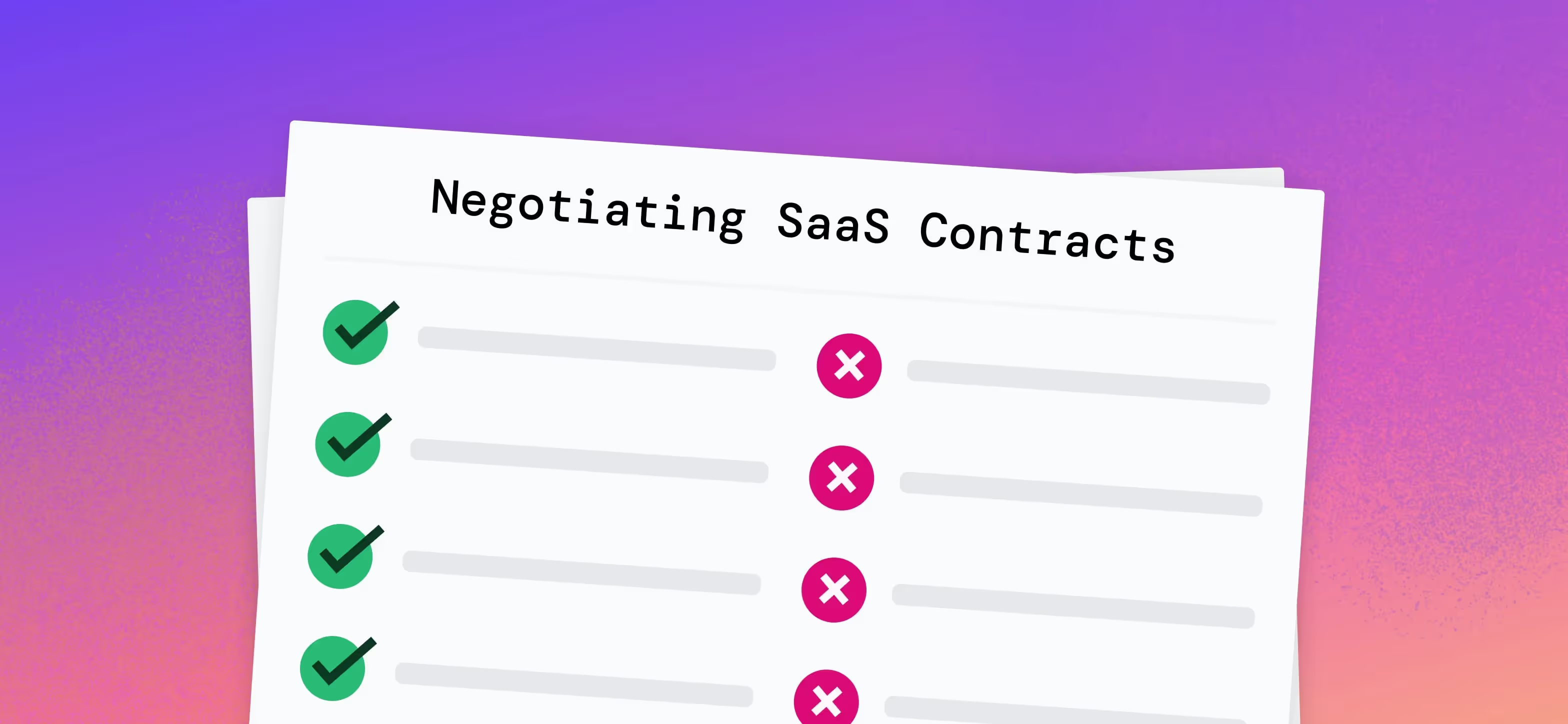We’ve said it before and we’ll say it again: Negotiating a SaaS contract is like navigating a high-stakes game of chess.
Several mistakes in a negotiation can sink your leverage and lock you into an unfavorable contract…similar to how a bevy of wrong moves on a chessboard can lead to a checkmate.
Knowing (and avoiding) the common pitfalls that companies make helps you maximize leverage on your side of the table.
Combine that with understanding whether you’re dealing with a seat-based or usage-based contract, along with utilizing the right questions to ask, and you put yourself several steps ahead in SaaS negotiations.
We enlisted the help of four Tropic procurement leaders to provide critical negotiation mistakes they see buyers make all the time, plus why it’s important to avoid them. Here’s what our expert negotiators had to say:
1. Omitting other suppliers from consideration

It might seem obvious to leverage competition during your negotiation, but you’d be surprised how much it gets overlooked.
One of the biggest negotiation gaffes is not evaluating other options in the market. After all, how do you know you might be paying more than you should for the software–or worse, buying the wrong one entirely?
How does this lever get overlooked in the first place?
Many companies simply lack time to properly evaluate competitors due to poor planning or a lack of resources. Here are some examples we see often:
- You may be dissatisfied with the uplifts the supplier is implementing, but your renewal date is approaching fast and you’ve already missed the delicate window to opt out of the contract and explore other options.
- You want to grab quotes from other providers but the amount of time needed to adequately compare pricing and terms against each other is more than you can afford.
- Maybe you don’t have the resources to conduct an RFP or simply don’t have the bandwidth to know (and even research) who a supplier’s competitors are.
The inability to assess the market gives way to committing other cardinal negotiation errors, like telling the supplier they’re the preferred option early into the negotiation (especially if it’s a new purchase). It’s a clear sign that you haven’t taken steps to research competitors, and it increases a supplier’s leverage and helps their ability to make their tool appear more sticky than it might be.
Your supplier relationship should be a partnership, but that doesn’t mean they should stop competing for your business year-over-year.
Without knowing what else is out there, how do you know if the price, product, and package you’re receiving are fair? Keeping an eye on the other players in the market is a good way to protect yourself and find out.
2. Providing your full projections to a supplier

The best time to get discounts on software is when you're making your initial purchase. Your next best shot at getting a better deal is when your business is growing significantly.
A deadly negotiation sin is sharing your exact growth plans for the next year. If you provide your growth projections to a supplier, you lose immediate leverage for additional rounds of negotiations, especially after the initial quote comes back.
Why? Suppliers typically don’t provide further incentives without a give and take, which often leads them to try to get you to commit to additional growth.
So, what’s the best way to avoid committing this grave mistake?
Start low. Inform your supplier rep that you’re thinking about potentially growing your contract over the next year and you’re interested to see if there are any incentives or discounts that they can provide or special promotions to take advantage of.
By starting with low to modest projections of growth, you’re establishing a starting point for additional discounts. As quotes are presented, you’ll then look to add additional growth in your next negotiations to ensure that you’re maximizing your potential discounting opportunity.

3. Rushing the entire process to completion

Build a good relationship with supplier reps, get the deal done, get the tool implemented, and move on to the next task as soon as possible.
That’s what you think is going to make your life as a buyer (and theirs as a supplier) easier, right?
A dangerous negotiation trap to avoid is rushing to get a new agreement in place, whether it be a renewal or a new purchase. By rushing to sign the dotted line, you miss out on the proper due diligence that’s needed to ensure you’re getting the right tool at the right price and terms for your team’s needs.
How can you avoid falling into this trap?
Engage early on and head into conversations understanding that it will take time and patience to achieve the results you are hoping for.
By engaging early, you allocate enough time for potential multi-round negotiations (which is always in your favor as Trevor mentions above). You also give yourself enough time to audit usage data and forecast growth.
Lastly, remember this: A supplier rep will always be more excited than the buyer to get the agreement wrapped up, whether they show it or not.
4. Glossing over contract term length

Not being strategic about contract term length can also lead to dire consequences.
On one hand, many companies tend to lock themselves into large multi-year deals, only to conduct a layoff several months later or see that the requirements for their business change down the line. The result? Unneeded and unwanted shelfware, which costs companies tens of billions of dollars per year.
On the other hand, multi-year contracts are down nearly 20% year-over-year, which means more companies are rigidly signing 12-month agreements to renew annually. What many of them don’t account for is the unfortunate compounding effect of uplifts as suppliers continue to raise prices every single year.
So, what are some strategic considerations to avoid making this costly mistake?
One-year deals are ideal for companies with a healthy degree of uncertainty. Questions to consider are:
- Not sure what your headcount growth looks like?
- Not sure what budgets will look like next year?
- Not sure if the ROI will come to fruition?
- Is this a new supplier?
Alternatively, a one-year deal isn’t always the right answer. Multi-year agreements make sense if at least 2 of the criteria below are met:
- The supplier is proven at your company (we’ve been using them and it works great).
- Switching would be incredibly costly and time-intensive (think ERP).
- The supplier tends to raise prices year over year.
Also, consider this: Savings come in many forms and should be looked at over multi-year periods. While one-year deals offer the ultimate flexibility, it might be more advantageous to sign a multi-year deal when you can get a bigger discount upfront and then lock in that price for multiple years.
Conversely, a multi-year deal guarantees your supplier a revenue source for years to come (in the tech world, that’s an eternity). It does give up your flexibility to find new (maybe better) solutions, shrink quantities, or remove SKUs. So it’s important to ensure you get something valuable in return, like a major discount. Too many companies give up this flexibility for a minor discount—or worse, nothing at all. That is nearly unforgivable.
Knowing (and avoiding) these four mistakes will help keep leverage on your side. If your team wants to supercharge SaaS negotiations even further, learn more about Expert Advisory to gain access to pricing benchmarks, supplier playbooks, or even 1-1 negotiation coaching.
Related blogs
Discover why hundreds of companies choose Tropic to gain visibility and control of their spend.







